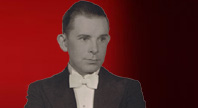

By the time he was twenty-seven years old, Stewart James had not yet liberated himself from the physical confines of the family home. However, his mind continued to venture into uncharted territories and to provide him with profoundly satisfying moments of imaginary escape. Much later, in a letter to Allan Slaight, James describes the destination of his creative wanderings as a hidden paradise filled with new discoveries:
The image of “Shangri-La,” a fictional Tibetan utopia in James Hilton’s novel Lost Horizon, is a fitting emblem for Stewart James. He reached his own intellectual haven by meditating upon particularly interesting tricks and methods. He spent much of his life in this more perfect, imaginary world. During one of his inner journeys there, he stumbled upon a little-known principle intrinsic to a deck of 52 playing cards. As a result, in 1935, James marketed “Miraskill,” an effect based on the mysterious principle discovered. Throughout the 20th and 21st centuries, a vast number of magicians have been inspired to create their own versions of this same card routine. But “Miraskill” has done much more than simply produce many imitations of one trick, it has drawn so much attention to the inherent principle involved – to its self-working modus-operandi – that it has generated a small movement in the intellectual history of magic. Various gifted magicians have gone to work tinkering with and testing the limits of the “Miraskill” principle, so that today an impressive amount of magic scholarship has been devoted to its study. In David Ben’s book Advantage Play (2001), a simplified presentation of the effect is used to illustrate the manner in which spectators make assumptions and the power of non-linear problem solving. In Stewart James in Print, Allan Slaight devotes an entire chapter – “Miraschool” – to variations on the “Miraskill” theme by James and other magicians. Two of the highlights from this chapter are Phil Goldstein’s “Miraskull” (SJP 1992) and Slaight’s own “Magnetic Miraskill” (SJP 1965). The short list above necessarily excludes the significant writings many other magicians have published related to “Miraskill.” Only a few titles have been listed to demonstrate the fact that James’ initial discovery has grown into a small school of thought in the magic community. Furthermore, Slaight’s, Goldstein’s, and others' routines all combine the “Miraskill” principle with another mathematical phenomenon – the Gilbreath principle. This combination of two especially deceptive card properties contained within a deck has culminated in a recent publication by David Williamson – Aunt Mary’s Terrible Secret (2003). His miniature, book-length text, contains the details of an extended, multi-phased performance he has devised using the “Miraskill” and “Gilbreath” principles together. In terms of influence upon other magicians, “Miraskill” may be the most famous card trick for which Stewart James is known. However, in his personal estimation, and in the popular opinion of the world at large, the young man from Courtright, Ontario, will always be remembered for his power to predict the future. In 1939, James performed two prediction tricks which shocked North America.
|
Copyright © 2007 Joe Culpepper and Magicana. All rights reserved.